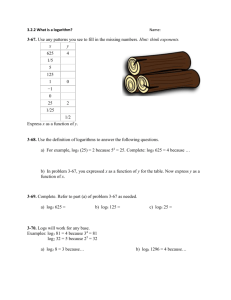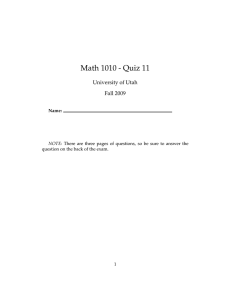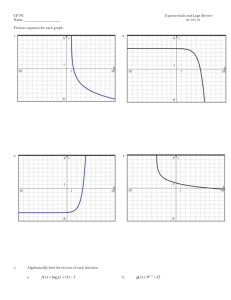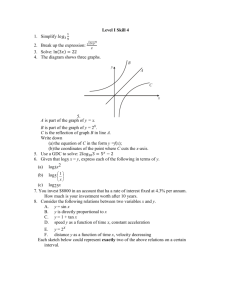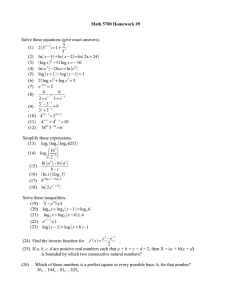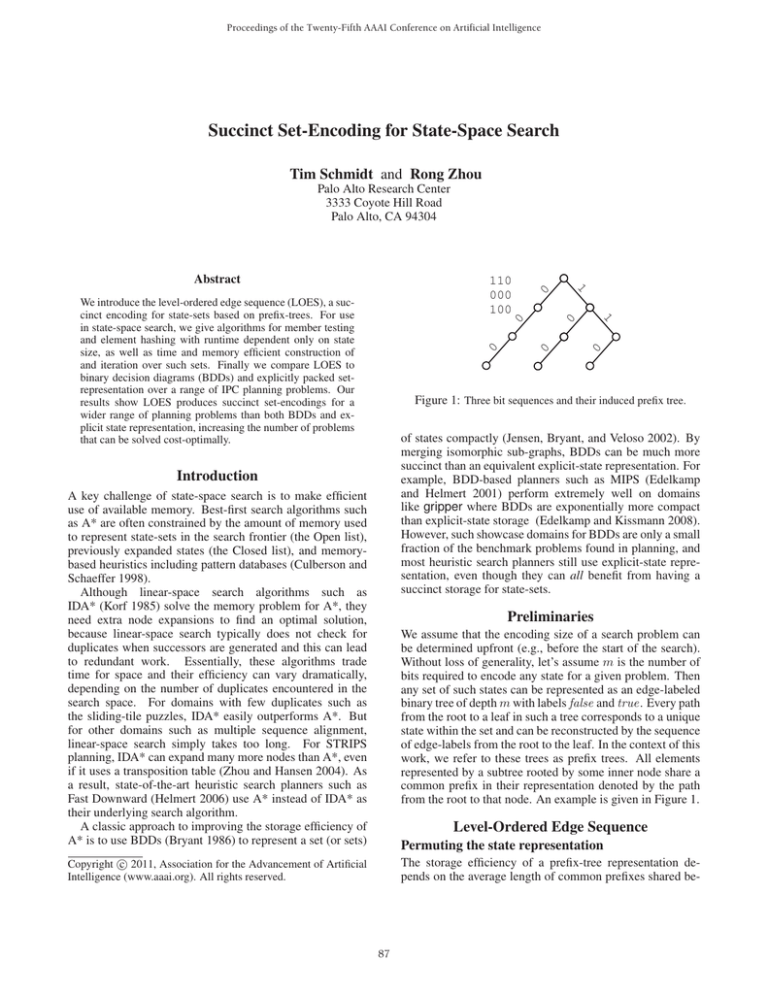
Proceedings of the Twenty-Fifth AAAI Conference on Artificial Intelligence
Succinct Set-Encoding for State-Space Search
Tim Schmidt and Rong Zhou
0
0
0
0
0
1
We introduce the level-ordered edge sequence (LOES), a succinct encoding for state-sets based on prefix-trees. For use
in state-space search, we give algorithms for member testing
and element hashing with runtime dependent only on state
size, as well as time and memory efficient construction of
and iteration over such sets. Finally we compare LOES to
binary decision diagrams (BDDs) and explicitly packed setrepresentation over a range of IPC planning problems. Our
results show LOES produces succinct set-encodings for a
wider range of planning problems than both BDDs and explicit state representation, increasing the number of problems
that can be solved cost-optimally.
1
110
000
100
Abstract
0
Palo Alto Research Center
3333 Coyote Hill Road
Palo Alto, CA 94304
Figure 1: Three bit sequences and their induced prefix tree.
of states compactly (Jensen, Bryant, and Veloso 2002). By
merging isomorphic sub-graphs, BDDs can be much more
succinct than an equivalent explicit-state representation. For
example, BDD-based planners such as MIPS (Edelkamp
and Helmert 2001) perform extremely well on domains
like gripper where BDDs are exponentially more compact
than explicit-state storage (Edelkamp and Kissmann 2008).
However, such showcase domains for BDDs are only a small
fraction of the benchmark problems found in planning, and
most heuristic search planners still use explicit-state representation, even though they can all benefit from having a
succinct storage for state-sets.
Introduction
A key challenge of state-space search is to make efficient
use of available memory. Best-first search algorithms such
as A* are often constrained by the amount of memory used
to represent state-sets in the search frontier (the Open list),
previously expanded states (the Closed list), and memorybased heuristics including pattern databases (Culberson and
Schaeffer 1998).
Although linear-space search algorithms such as
IDA* (Korf 1985) solve the memory problem for A*, they
need extra node expansions to find an optimal solution,
because linear-space search typically does not check for
duplicates when successors are generated and this can lead
to redundant work. Essentially, these algorithms trade
time for space and their efficiency can vary dramatically,
depending on the number of duplicates encountered in the
search space. For domains with few duplicates such as
the sliding-tile puzzles, IDA* easily outperforms A*. But
for other domains such as multiple sequence alignment,
linear-space search simply takes too long. For STRIPS
planning, IDA* can expand many more nodes than A*, even
if it uses a transposition table (Zhou and Hansen 2004). As
a result, state-of-the-art heuristic search planners such as
Fast Downward (Helmert 2006) use A* instead of IDA* as
their underlying search algorithm.
A classic approach to improving the storage efficiency of
A* is to use BDDs (Bryant 1986) to represent a set (or sets)
Preliminaries
We assume that the encoding size of a search problem can
be determined upfront (e.g., before the start of the search).
Without loss of generality, let’s assume m is the number of
bits required to encode any state for a given problem. Then
any set of such states can be represented as an edge-labeled
binary tree of depth m with labels false and true. Every path
from the root to a leaf in such a tree corresponds to a unique
state within the set and can be reconstructed by the sequence
of edge-labels from the root to the leaf. In the context of this
work, we refer to these trees as prefix trees. All elements
represented by a subtree rooted by some inner node share a
common prefix in their representation denoted by the path
from the root to that node. An example is given in Figure 1.
Level-Ordered Edge Sequence
Permuting the state representation
c 2011, Association for the Advancement of Artificial
Copyright Intelligence (www.aaai.org). All rights reserved.
The storage efficiency of a prefix-tree representation depends on the average length of common prefixes shared be-
87
0
0
0
0
0
0
0
0
0
0
0
0
1
1
0
1
011
000
010
1
1
0
1
110
000
100
10
Figure 2: Permuting the encoding’s bit-order can reduce the size
11
10
11
of a prefix tree.
Figure 3: Level-ordered edge sequence for the example set.
tween members of the represented set, which in turn depends on the ordering of bits used in the state-encoding (see
Fig.2 for an example). To efficiently find a suitable order,
we greedily search through permutations on the bit-order to
find one that maximizes the average length of the common
prefixes. As a first step we generate a sample set of states
starting from a singleton set comprising of the initial state.
At each iteration we randomly pick a state from this set, generate its successors and add them back to the set. The process ends after the set has either grown to a specified size or
a fixed number of iterations have been executed, whichever
happens first. The random selection is aimed at generating a
good sample of valid states at different search depths.
this process will move bits whose value is near-constant in
the sample set to the most significant bit positions in the permuted string.
LOES encoding
While the tree representation eliminates prefix redundancy
among set-members, straightforward implementations can
easily exceed a simple concatenation of the members’ bitstrings in size. The culprit are pointers, each of which can
take up to 8 bytes of storage on current machines. An alternative are pointer-less structures such as the Ahnentafel1
representation of binary heaps. A historical Ahnentafel represented the generation order of individuals solely through
their positions in the document. At the first position is the
subject. The ordering rule is that for any individual at position i, the male ancestor can be found at position 2i and
the female ancestor at position 2i + 1 with the offspring to
be found at position i/2. More generally a binary tree is
stored in an array through a bijection which maps its elements (individuals) to positions in the array in level-order
(i.e. the order of their generation). This technique is well
suited for full binary trees (such as binary heaps), but relatively costly for general binary trees. However it can be
adapted as we will see in the following.
First, an information-theoretical view on the encoding of
binary trees. The number of different binary trees w.r.t. their
number of nodes is given by the Catalan numbers.
n−1
C0 = 1, Cn = i=0 Ci Cn−1−i for n ≥ 0
Stirling’s approximation gives log2 Cn as 2n + O(n),
which gives us an idea of the information theoretic minimum
number of bits required to represent a general binary tree
of n nodes. Different encodings exist (see (Jacobson 1988)
and (Munro and Raman 2001) for examples) that can store
such trees with 2 bits per tree-node and support for basic tree
navigation with little additional space overhead. Our prefixtrees are constrained in that all leaves are at depth m − 1.
We devised an encoding that exploits this property, which
results in shorter codes as well as simpler and faster algorithms. We call this encoding Level-Ordered Edge Sequence
or LOES. It is defined as the level-order concatenation of 2bit-edge-pair records for each inner node of the tree (the bits
corresponding to the presence of the false and true edges at
that node). Figure 3 shows how this allows us to encode our
Algorithm 1: minimal entropy bit-order
Input: sampleset a set of sampled states
Output: bitorder a permutation of the state encoding
subtrees ← {sampleset};
bitorder ← ;
while unassigned bit-positions do
foreach unassigned bit-position p do
subtreesp ← {∅};
foreach S ∈ subtrees do
p
Strue
← {s ∈ S : s[p] = true};
p
p
← S/Strue
;
Sfalse
p
p
p
subtrees ← subtreesp ∪ {Strue
} ∪ {Sfalse
};
p∗ ← argmin{H(subtreesp )};
p
bitorder ← bitorder ◦ p∗ ;
∗
subtrees ← subtreesp ;
Then we deduce a suitable bit-order by greedily constructing a prefix tree over these sample states in a top-down fashion (see Algorithm 1). Each iteration begins with sets for
each leaf node of the current tree, holding the subset with
the prefix corresponding to the path from the root to the leaf
node. The process starts with a single leaf-set comprising
of all sample states, an empty bit-order and all bit-positions
designated as candidates. During an iteration we look at
each remaining unassigned candidate bit and create a temporary new tree layer by partitioning each set according to
the value of this bit in its states. To maximize average prefix lengths we choose the candidate with the least entropy
in its leaf-sets as next in the bit-order. It ends after m iterations, when all candidates have been assigned. Intuitively
1
88
German for ancestor table.
test?
10111011
2
0
Figure 4: Path offset computation for 001 in the example set.
At each level, we compute the offset of the corresponding edgepresence bit, test the bit, continue on pass and return ⊥ on a fail.
With these indices, the rank function comprises of straightforward look-ups of the block and sub-block indices and setbit counting within the sub-block.
Algorithm 2: path-offset
Input: state a bitsequence of length m
Output: offset an offset into LOES
Data: LOES an encoded state-set
offset ← 0;
for depth ← 0 to m − 1 do
if state[depth] then
offset ← offset + 1;
if LOES[offset] then
if depth = m − 1 then
return offset;
else
else
offset ← 2rankLOES (offset);
return ⊥;
Path-offset The path-offset function (Algorithm 2) navigates through the LOES according to the path interpretation
of a state. If the state represents a valid path from the tree
root to some leaf, the function returns the offset of the bit
corresponding to the last edge of the path. Else it evaluates
to ⊥. An example is given in Figure 4
Member test Based on the offset function, member tests
are straightforward. A set contains a state, if and only if its
path interpretation corresponds to a valid path through the
prefix tree.
Rank Our implementation makes use of a two-level index, which logically divides the LOES into blocks of 216
bits and sub-blocks of 512 bits. For each block, the index
holds an 8-byte unsigned integer, denoting the number of
set bits from the beginning of the sequence up to the beginning of the block. On the sub-block level, a 2-byte unsigned
value stores the number of set bits from the beginning of the
corresponding block up to the beginning of the sub-block.
The index overhead within a block is hence
block index
10111011
!
FAIL
For use in state-space search or planning we need to enable
three different operations in a time and space efficient way:
(1) set-member queries, (2) a bijective mapping of a set’s n
elements to integers 0 . . . n − 1 to allow efficient association
of ancillary data to states and (3) iterating over set elements.
All of these operations require efficient navigation through
the LOES. For any edge in the sequence at some offset o, the
entries for the false and true edges of the node it points to
can be found at offsets 2rank (o) and 2rank (o) + 1, where
rank (o) is a function that gives the number of set bits in the
sequence up to (and including) offset o. This is, because
each set bit (present edge) in the LOES code results in an
edge-pair record for the target node on the next level (with
the exception of the leaf level). As these records are stored in
level order, all preceding (in the LOES) edges result in preceding child records. Hence the child record for some edge
at offset o will be the rank (o) + 1-th record in the sequence
(as the root node has no incoming edge). Transforming this
to offsets with 2-bit records, 2rank (o) and 2rank (o)+1 then
give the respective offsets of the presence bits of the target
node’s false and true edges.
16
29
test?
1
i2 = 2rank(i1)+s[2]=5
Tree operations
64
+
216
t?
tes
10111011
1
i1 = 2rank(i0)+s[1]=2
0
1
Space requirements of LOES-sets For a set of n unique
states, the prefix tree is maximal, if the average common
prefix length of the states is minimal. Intuitively this results in a structure that resembles a perfect binary tree up to
depth k = log2 n and degenerate trees from each of the
nodes at depth k. Hence the set-tree will at most encompass 2n + n(m − k) nodes. For large sets of long states (i.e.
log2 n m n) this is less than (2 + m)n ≈ nm nodes.
As each node (with the exception of the tree root) has exactly one (incoming) edge and each record in LOES holds
at least one edge, the code will at most be little more than
twice the length of the concatenation of packed states in the
set.
The best case results from the opposite situation, when
the structure represents a degenerate tree up to depth j =
m − log2 n, followed by a perfect binary tree on the lower
levels. Such a tree comprises of 2n + (m − j) nodes, with
each record in the binary tree representing two edges. For
large sets (i.e. m n), 2n bits is hence a tight lower bound
on the minimal length of the LOES code.
0
has s=001?
i0 :=s[0]=0
0
example set in a single byte, little more than half the length
of the more general encodings mentioned above.
Member index Function member index (Algorithm 3)
maps states to values {⊥, 0, . . . , n − 1}. It is bijective for all
member states of the set and hence allows associating ancillary data for each member without requiring pointers. The
idea is that each set-member’s path corresponds to a unique
edge at the leaf-level of the tree. The path-offset function
gives the address of that bit. By computing the rank of the
address, each state is assigned a unique integer in a consecutive range. We normalize these values to the interval [0; n)
by subtracting the rank of the last offset of the last but one
layer +1. Figure 5 shows this for our example set.
≈ 0.0323
sub-block index
89
Algorithm 3: member index
Algorithm 4: advance iterator
Input: state a bitsequence of length m
Data: LOES an encoded state-set
Data: levelOffsets array of offsets
Data: LOES an encoded state-set
Data: offsets an array of LOES offsets
level ← m − 1;
continue ← true;
while continue & level ≥ 0 do
recid ← offsets[level]
;
2
repeat
offsets[level] ← offsets[level] + 1;
until LOES[offsets[level]] = true;
;
continue ← recid = offsets[level]
2
level ← level − 1;
o ← path-offset(state );
if o = ⊥ then
return ⊥;
a ← rankLOES (o);
b ← rankLOES (levelOffsets[m − 1] − 1);
return a − b − 1;
from the offsets-array. Note that the iteration always returns
elements in lexicographical order. We will make use of this
property during set construction.
10111011 LOES
0
Set construction
34 56 rank
0
1
0
0
1
Algorithm 5: add state
000 > 4-3-1=0
010 > 5-3-1=1
011 > 6-3-1=2
Input: s a bitsequence of length m
Data: treelevels an array of bitsequences
Data: s’ a bitsequence of length m or ⊥
if s’ = ⊥ then
depth ← −1;
Figure 5: Index mappings for all states in the example set. We
subtract the rank+1 (of the offset) of the last edge in the last-butone level from the rank of the path-offset of an element to compute
its index.
if s’ = s then
return;
else
Set iteration Set-iteration works by a parallel sweep over
the LOES subranges representing the distinct levels of the
tree. The first element is represented by the first set bit on
each level. The iteration ends after we increased the leafoffset past the last set bit in the LOES. Algorithm 4 gives
the pseudocode for advancing the iteration state from one
element to the next element in the set. Conceptually, starting from the leaf-level, we increase the corresponding offset
until it addresses a set-bit position. If this advanced the offset past a record boundary (every 2 bits) we continue with
the process on the next higher level. Figure 6 shows the different iteration states for our running example. Even-offsets
into the LOES correspond to f alse labels and odd-offsets
to true labels. Hence elements can be easily reconstructed
10111011
024 > 000
10111011
10111011
036 > 010
037 > 011
depth ← i : ∀j < i, s[j] = s’[j] ∧ s[i] = s’[i];
treelevels[depth].lastBit ← true;
for i ← depth + 1 to m − 1 do
if s [i] then
treelevels[i] ← treelevels[i] ◦ 01;
else
treelevels[i] ← treelevels[i] ◦ 10;
s’ ← s;
LOES is a static structure. Addition of an element in general necessitates changes to the bit-string that are not locally
confined, and the cost of a naive insertion is hence O(n).
To elaborate on this topic, we first consider how a sequence
of lexicographically ordered states can be transformed into
LOES. We first initialize empty bit-sequences for each layer
of the tree. Algorithm 5 shows how we then manipulate
these sequences when adding a new state. If the set is empty,
we merely append the corresponding records on all levels.
Else, we determine the position or depth d of the first differing bit between s and s , set the last bit of sequence d
to true and then append records according to s to all lower
levels. Duplicates (i.e. s = s ) are simply ignored. After
the last state has been added, all sequences are concatenated
in level-order to form the LOES. Figure 7 shows this process for our running example. Due to its static nature, it
is preferable to add states in batches. An iteration over a
Figure 6: Iteration over the example set. The first row shows the
LOES offsets at each iteration state (black, gray and white corresponding to tree levels 0,1,2). The second row shows how these
offsets (mod 2) give the elements represented by the LOES.
90
Instance
Airport-P7
Airport-P8
Airport-P9
Blocks-7-0
Blocks-7-1
Blocks-7-2
Blocks-8-0
Blocks-8-1
Blocks-8-2
Blocks-9-0
Blocks-9-1
Blocks-9-2
Blocks-10-0
Blocks-10-1
Blocks-10-2
Depots-3
Depots-4
Driverlog-6
Driverlog-4
Driverlog-5
Driverlog-7
Driverlog-8∗
Freecell-2
Freecell-3
Freecell-4
Freecell-5
Freecell-6∗
Gripper-5
Gripper-6
Gripper-7
Gripper-8
Gripper-9
Microban-4
Microban-6
Microban-16
Microban-5
Microban-7
Satellite-3
Satellite-4
Satellite-5
Satellite-6
Satellite-7∗
Travel-4
Travel-5
Travel-6
Travel-7
Travel-8
Travel-9∗
Mystery-2
Mystery-4∗
Mystery-5∗
8-Puz-39944
8-Puz-72348
15-Puz-79∗
15-Puz-88∗
000 10 010 10 011 10
10111011
10
11
11
10
1010
1011
Figure 7: Construction of the set by adding the example states in
lexicographic order with algorithm 5. After all states are added, the
sequences are concatenated in level-order to form the LOES.
LOES-set returns elements in lexicographical order. In this
way, we can iterate over the initial set and the lexicographically ordered batch of states in parallel and feed them to
a new LOES in the required order. If the batch is roughly
the size of the set, the amortized cost of an insertion is then
O(log n). The log stems from the need to have the batch in
lexicographical order. In this context, we just want to note
that any search or planning system based on LOES should
be engineered around this property.
Peak-memory requirements To minimize the memory
requirements of these merge operations, our bit-sequences
comprise of equal size memory chunks. Other than the usual
bitwise operators, they support destructive reads in which
readers explicitly specify their subrange(s) of interest. This
allows to free unneeded chunks early and significantly reduces the peak memory requirements of LOES merges.
Empirical Evaluation
For our empirical evaluation, we concentrate on peakmemory requirements during blind searches in a range of
IPC domains. To this end, we implemented a breadth-first
search environment for comparative evaluation of LOES and
BDDs. We also compared LOES with a state-of-the-art
planner, Fast Downward (FD) in its blind-heuristic mode.
We used SAS+ representations generated by FD’s preprocessor as input for all our tests. The BDD version of our
planner is based on the BuDDy package (Lind-Nielsen et al.
2001), which we treated as a black-box set representation.
After each layer, we initiated a variable-reordering using the
package’s recommended heuristic. As the order of expansions within a layer generally differs due to the inherent iteration order of the BDD and LOES versions, we looked at
Open and Closed after expanding the last non-goal layer for
our tests. During the evaluation, we used 128-byte chunks
for LOES’ bit-strings, as well as a one megabyte buffer for
packed states, before we transformed them into LOES. The
test machine used has two Intel 2.26 GHz Xeon processors
(each with 4 cores) and 8GB of RAM. No multi-threading
was used in the experiments.
Table 1 gives an overview of the results. For the size
comparison, the table gives the idealized (no padding or
other overhead) concatenation of packed states (Packed) as
a reference for explicit state storage. In all but the smallest instances, LOES’ actual peak-memory requirement is
well below that of (ideally) Packed. Set-elements on average required between 6 − 58% of the memory of the ideally
packed representation on the larger instances of all test do-
|O ∪ C|
765
27,458
177,075
38,688
64,676
59,167
531,357
638,231
439,349
8,000,866
6,085,190
6,085,190
103,557,485
101,807,541
103,557,485
3,222,296
135,790,678
911,306
1,156,299
6,460,043
7,389,676
82,221,721
142,582
1,041,645
3,474,965
21,839,155
79,493,417
376,806
1,982,434
10,092,510
50,069,466
243,269,590
51,325
312,063
436,656
2,200,488
25,088,052
19,583
347,124
39,291,149
25,678,638
115,386,375
7,116
83,505
609,569
528,793
14,541,350
68,389,737
965,838
38,254,137
54,964,076
181,438
181,438
23,102,481
42,928,799
mpck
0.01
0.57
4.60
0.13
0.22
0.20
2.60
3.12
2.15
43.87
33.37
33.37
629.60
618.96
629.60
19.97
1068.38
3.58
3.72
23.10
34.36
411.67
0.97
9.19
36.04
278.57
1137.16
1.48
8.74
50.53
280.53
1479.00
0.39
3.01
4.89
22.30
287.11
0.04
0.95
182.67
97.96
591.47
0.02
0.22
1.82
1.58
62.40
317.95
13.47
228.01
563.49
0.78
0.78
176.26
327.52
mloes
0.01
0.26
1.54
0.09
0.14
0.13
1.37
1.51
1.13
19.13
16.54
15.10
271.02
275.43
283.75
2.77
147.98
0.81
0.83
4.45
5.66
64.08
0.52
4.47
20.19
128.10
519.96
0.11
2.06
2.69
13.22
133.92
0.20
1.33
2.05
10.35
122.66
0.01
0.12
14.27
8.27
37.96
0.01
0.07
0.41
0.46
10.28
50.93
3.09
23.52
150.90
0.42
0.43
102.32
188.92
mbdd
0.61
9.82
100.32
0.61
1.23
1.23
9.82
4.91
4.91
39.29
39.29
39.29
130.84
283.43
130.84
69.81
924.29
0.61
0.61
1.23
1.23
4.91
9.82
39.29
100.32
MEM
MEM
0.31
0.31
0.61
0.61
1.23
2.46
4.91
2.46
69.81
741.19
0.04
0.08
4.91
0.61
2.46
0.08
0.31
1.23
0.61
19.64
161.36
19.64
19.64
130.84
4.91
4.91
558.08
771.70
tf d
0
1
5
0
0
0
5
6
4
90
73
75
MEM
MEM
MEM
72
MEM
21
20
162
233
MEM
3
25
95
MEM
MEM
3
20
123
MEM
MEM
0.43
3.27
5
29.3
MEM
0
13
MEM
MEM
MEM
0.08
1.46
14.4
8.45
MEM
MEM
88.6
MEM
MEM
1.08
1.04
MEM
MEM
tloes
0.8
43.92
395.58
2.89
7.45
5.56
64.99
87.77
49.32
1832.57
1265.1
1189.86
110602
112760
110821
1174.48
373273
144.74
195.22
1689.65
2735.61
228181
80.81
904.13
4321.72
53941.8
481452
65.26
466.55
2894.97
22720.9
410729
9.57
247.02
329.95
676.4
24574.1
2.25
74.5
28580.9
13684.6
380135
0.42
7.6
77.09
71.61
8178.87
167795
469.84
11674.1
290441
26.49
26.37
17525.6
71999.7
Table 1: Empirical results for a number of IPC domains, including
(1) a comparison of peak-memory requirements between an idealized concatenated bit-string of packed states, LOES and BDD and
(2) a comparison of runtimes between Fast Downward (FD) and
LOES. |O ∪ C| is the number of states in Open and Closed before the goal layer, mpck , mloes and mbdd are the respective peak
memory requirements (in MB) of Packed, LOES and BDD storage
components. tf d and tloes are the respective runtimes in seconds
(or MEM if the process ran out of memory). Instances marked
by ∗ were those that exceeded our time allowance, in which case
we included numbers from the largest layer both BDD and LOES
processed. The naming of the 8-Puzzle instances is based on a lexicographic ordering of all such instances between 1 and 9!/2. The
15-Puzzle instances are from (Korf 1985).
mains. As LOES eliminates a significant fraction of the redundancies BDD exploits, its compression rate is analogous
to the latter, albeit the variance is much smaller. LOES in
particular avoids the blow-up BDDs suffer in domains like
freecell, microban and the n-puzzles, showing robustness
across all test domains. LOES also does not rely on large
sets for good compression, making it even more attractive
91
state encoding and not on the size of the set. For the immediate future, an obvious application for LOES is pattern
databases (PDBs). This class of heuristics traditionally depends on space-efficient representations with good look-up
performance. LOES’ static nature and potential construction
overhead is of little concern for PDBs. We expect that LOES
or similar representations have a future in duplicate detection and general set representations for heuristic search. We
note that a sorted list of packed states can be transformed
to LOES with little overhead and that LOES provides good
compression even on small sets. Also a merge sort like construction where very imbalanced LOES merges are delayed
until a similar-sized counterpart exists can help to achieve
an amortized O(log n) construction. In both cases currently
unused RAM can be used straightforwardly to speed up set
construction, while the minimal peak-memory construction
approach of our implementation can serve as a fallback as
memory becomes scarce.
than BDDs if the majority of the search space can be pruned
away by a good heuristic function. Another key advantage
over BDDs is that LOES allows one to easily associate arbitrary data to set elements without using pointers, which
represent a significant storage overhead in symbolic as well
as explicit-state search.
Instance
Blocks-9-0
Depots-3
Driverlog-7
Freecell-4
Gripper-7
Microban-5
Satellite-4
Travel-6
Airport-9
loes
f d64bit
f d32bit
46.8
17.8
37.9
53.7
13.7
31.6
18.6
22.1
11.4
1460.3
737.2
3686.1
1092.9
1720.5
682.9
101.8
225.1
171.9
990.9
553.9
2142.9
866.6
1159.4
422.9
64.2
124.0
152.8
loes
f d64bit
0.03
0.02
0.01
0.05
0.01
0.05
0.18
0.10
0.07
Table 2: Peak allocated process memory for LOES and FD (64
and 32 bit binaries) in MB.
It can be observed from Table 1 that the runtime comparison is not in favor of LOES, which took about 10 and 20
times longer than FD on the larger instances both can solve.
While certain overhead stems from employing LOES, a significant part is due to our current implementation, which can
be substantially improved. To expand a node, our implementation performs a linear scan in the entire set of grounded
operators to find the ones whose preconditions are satisfied;
whereas FD uses a decision tree to quickly determine the set
of applicable operators. Of course, the speed of our planner
can be improved if the same decision tree were used. Another source of overhead is that our current implementation
is not particularly optimized for bulk insertions, since we
only used a small buffer to accommodate newly generated
successors and whenever the buffer is full, it is combined
with the next-layer LOES, which includes iterating over all
previously generated states in the next layer.
Of course, FD does not store states in an ideally packed
representation and instead uses highly time-efficient C++
STL-components for set storage. This results in significant
space overhead. Table 2 gives a comparison of the peak process memory allocations for LOES and FD on the largest
instance of each domain that both can solve. To show the
influence of pointers, we also included numbers for a 32 bit
binary of FD. As shown in the table, FD uses up to two orders of magnitude more RAM than LOES. Given FD’s more
advanced successor generator, it is somewhat surprising that
LOES is only slower by a constant factor as the size of the
instance increases in each domain.
References
Bryant, R. E. 1986. Graph-based algorithms for boolean
function manipulation. IEEE Transactions on Computers
35:677–691.
Culberson, J., and Schaeffer, J. 1998. Pattern databases.
Computational Intelligence 14(3):318–334.
Edelkamp, S., and Helmert, M. 2001. The model checking
integrated planning system (mips). AI Magazine 22(3):67–
71.
Edelkamp, S., and Kissmann, P. 2008. Limits and possibilities of bdds in state space search. KI 2008: Advances in
Artificial Intelligence 46–53.
Helmert, M. 2006. The fast downward planning system.
Journal of Artificial Intelligence Research 26(1):191–246.
Jacobson, G. 1988. Succinct static data structures. Ph.D.
Dissertation, Carnegie Mellon University Pittsburgh, PA,
USA.
Jensen, R. M.; Bryant, R. E.; and Veloso, M. M. 2002.
SetA*: An efficient BDD-based heuristic search algorithm.
In Proceedings of AAAI-2002, 668–673.
Korf, R. 1985. Depth-first iterative-deepening: An optimal
admissible tree search. Artificial Intelligence 27(1):97–109.
Lind-Nielsen, J.; Andersen, H.; Hulgaard, H.; Behrmann,
G.; Kristoffersen, K.; and Larsen, K. 2001. Verification of
large state/event systems using compositionality and dependency analysis. Formal Methods in System Design 18(1):5–
23.
Munro, J., and Raman, V. 2001. Succinct representation
of balanced parentheses and static trees. SIAM Journal on
Computing 31:762.
Zhou, R., and Hansen, E. 2004. Breadth-first heuristic
search. In Proceedings of the 14th International Conference
on Automated Planning and Scheduling, 92–100.
Conclusion and Future Work
LOES shows good space efficiency for representing explicit
state-sets of all sizes. It provides robust space savings even
in traditionally hard combinatorial domains such as the npuzzles. In particular, it defines a consecutive address-space
over set elements, which allows space-efficient association
of ancillary data to set-elements without addressing overhead. In theory, LOES should also offer good time efficiency, especially on larger problems, because its complexity of set-member testing depends only on the size of the
92


